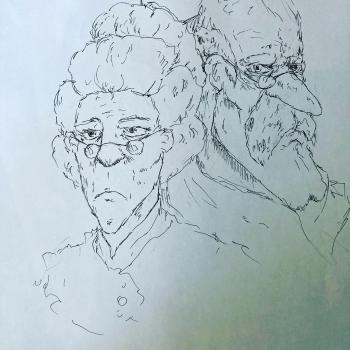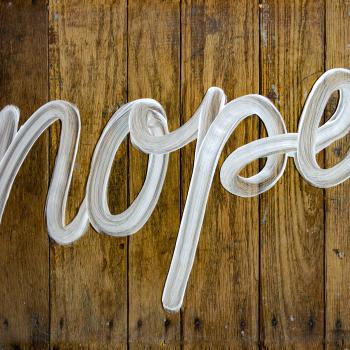Matt found and posted on Facebook this fantastic picture of Trump crushing the serpent (who, you know, in the Bible, is Satan) under his heel while in the foreground, illuminated by a ray of sunlight, a young man plants a seedling. I guess I should have said painting rather than picture, for this amazing image sprung fully formed from the mind and brush of Jon McNaughton, that wondrous ‘artist’ who formerly has painted Jesus in company with people like Ronald Reagan and the hard working common man.
I love all those pictures so much–almost as much as this heroin Jesus, and this clever idea of being photographed with someone who looks like Jesus. Just think, if there were no internet, we wouldn’t even know about this splendid artistic venture. The internet is good for Everything.
Including photoshopping pictures of sharks into the flood waters of Houston. And that image of the airport being much more flooded than it actually is. It’s so easy to click around and just throw something up that says Something.
But what? When you fling a picture onto the Internet–like I try to do every morning, in obedience to the gods of blogging who have figured out that if there is a picture, especially a picture of a face, some of you will be more likely to click than not–what does the picture itself say? Or do? And is it what you would have said if you were going to use words?
That picture of Trump, the end of the snake protruding from underneath his shoe…I’m just curious. Would the artist be willing to put into words the implications of his picture? Would he say baldly, with words, ‘I think Trump is Jesus and is crushing Satan under his heel.’ (Actually, I’m sort of afraid that he would be willing to say that so I’m going to avoid asking him directly.) The picture is powerful, in a fluffy, let me not really think too much but just feel all my feelings way. Pictures in general are powerful, which is why we’re supposed to use them.
But their power, I think, consists in the fact that you can see whatever you want. You can draw your own conclusions much more easily than if words had been the main event. For all that post modernism has overtaken and deconstructed some of the essential words and concepts of the past thousand years–words like Truth, Beauty, Love, Tolerance, Goodness–they remain fairly effective as a means of communicating, precisely because they do have clear meaning. If I say something with words, you have something pretty clear to disagree with and malign, or to love and rejoice over.
But if I just post a picture, I can come back later and say, ‘well that’s not what I saw,’ or, ‘you didn’t see this bit over here.’ It allows all my subjectivity, and yours, to fall under the shaft of sunlight in the emotional foreground, rather than staking out any objective dust for true engagement.
Really, though, I’m just self justifying my own prejudices. I can’t draw worth anything, and I’m not good at taking pictures, and I don’t really like Pinterest, and when I see an article and the picture irritates me I don’t click on it, but when I see close set blocks of text with no pictures anywhere I feel a thrill of hope. I don’t really like pictures, except of flowers. I prefer words. And so the culture of pictures must be wrong because it doesn’t personally suit me. I must be right.
Except for Trump as Jesus. If loving that picture is wrong, I don’t ever wanna be right. I would almost pay money to see that in person.













